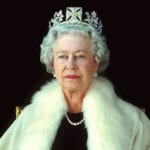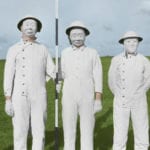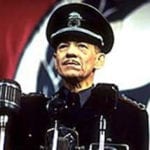 Our World
Our World  Our World
Our World  Pop Culture
Pop Culture 10 Incredible Female Comic Book Artists
 Crime
Crime 10 Terrifying Serial Killers from Centuries Ago
 Technology
Technology 10 Hilariously Over-Engineered Solutions to Simple Problems
 Miscellaneous
Miscellaneous 10 Ironic News Stories Straight out of an Alanis Morissette Song
 Politics
Politics 10 Lesser-Known Far-Right Groups of the 21st Century
 History
History Ten Revealing Facts about Daily Domestic Life in the Old West
 Weird Stuff
Weird Stuff 10 Everyday Products Surprisingly Made by Inmates
 Movies and TV
Movies and TV 10 Actors Dragged out of Retirement for One Key Role
 Creepy
Creepy 10 Lesser-Known Shapeshifter Legends from Around the World
 Our World
Our World 10 Science Facts That Will Change How You Look at the World
 Pop Culture
Pop Culture 10 Incredible Female Comic Book Artists
 Crime
Crime 10 Terrifying Serial Killers from Centuries Ago
Who's Behind Listverse?

Jamie Frater
Head Editor
Jamie founded Listverse due to an insatiable desire to share fascinating, obscure, and bizarre facts. He has been a guest speaker on numerous national radio and television stations and is a five time published author.
More About Us Technology
Technology 10 Hilariously Over-Engineered Solutions to Simple Problems
 Miscellaneous
Miscellaneous 10 Ironic News Stories Straight out of an Alanis Morissette Song
 Politics
Politics 10 Lesser-Known Far-Right Groups of the 21st Century
 History
History Ten Revealing Facts about Daily Domestic Life in the Old West
 Weird Stuff
Weird Stuff 10 Everyday Products Surprisingly Made by Inmates
 Movies and TV
Movies and TV 10 Actors Dragged out of Retirement for One Key Role
 Creepy
Creepy 10 Lesser-Known Shapeshifter Legends from Around the World
Top 10 Nazi Links To The British Royals
As we have all been reminded these past few weeks, the royal family is no stranger to controversy. With so much money, power, and influence, this is hardly surprising. But when you have so much money, power, and influence, everything you do tends to be pretty well-documented, so no matter how well you think you hide something, who knows what historians in the future could uncover. In the case of the Royal family, it seems there are a few connections they tried to hide, but ones that historians today felt were too good to leave buried.
See Also: 10 Plans Hitler Would Have Put In Motion If The Nazis Had Won
10 Edward VIII
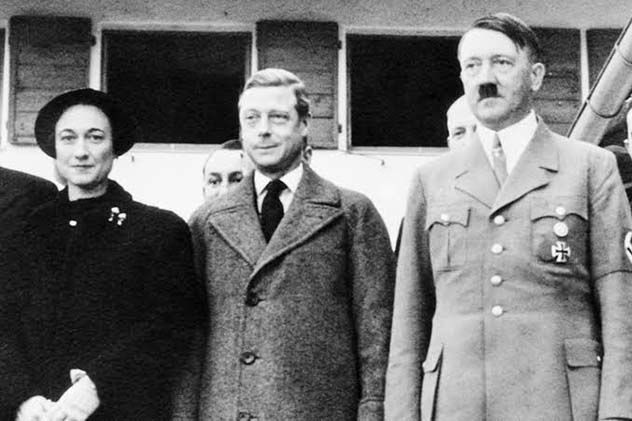
If you’ve seen the movie The King’s Speech, then you’ve already got an understanding of why King Edward VIII is so famous. That’s right, the man who worked so hard at overcoming his fears and inspiring the nation was none other than his brother George VI, who became the unexpected King when Edward abdicated in 1936. Now pretty much known as the man who gave us Queen Elizabeth, there is a lot more to Edward’s story than the first few minutes of that film would suggest.
You may think that working as an officer in World War 1 would have instilled some anti-German sentiment in young Edward, but it seems the opposite is true. Having witnessed the horrors of war, he grew up with a desire to ensure that the UK and Germany had better relations moving forward, and his sympathies for the Nazis are well-documented.[1] In the early 1930s, this wouldn’t have been particularly uncommon, but the fact that he was heir to the throne made his support a little more controversial.
In 1934, the Prince began an affair with his future-wife, a twice-divorced American named Wallis Simpson. Although the public were unaware of the relationship, both British & US intelligence suspected Wallis Simpson of being a Nazi spy. She was accused of having a second affair with Germany’s ambassador to the UK, Joachim Von Ribbentrop,[2] and of passing on sensitive information to the Nazis. However, neither of these allegations have ever been proven, and it is possible that they were simply character attacks aimed at a woman who had the gall to marry three times.
During World War 2, Edward gave speeches advocating reconciliation both before and after his abdication, much to the chagrin of the British people. In 1937, he even took his controversial new-wife on an official visit to Germany, where they were met with cheering crowds, Nazi salutes (which they reciprocated), and even joined the Fuhrer himself for some afternoon tea. Although Edward told an interviewer in 1966 that he had been “foolish and naive”[3] about Hitler, it is hard not to look back and wonder if there was more to this story that hasn’t come to light.
9 Churchill’s Weeders
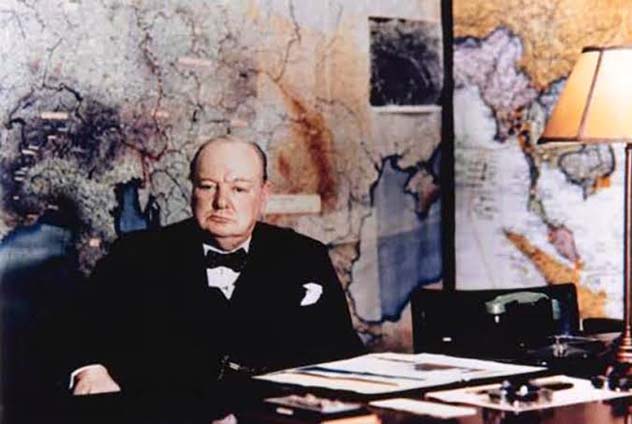
We often hear that history is written by the victors, but most of us probably underestimate just how much work goes into the editing process before that history is published. That saying is often (albeit, unreliably) attributed to Churchill himself, and while he may not have been the first to say it, he certainly took the advice to heart.
As soon as the war was over, one of Churchill’s first acts was establishing an elite team known as “the Weeders”. Their job was to sift through any records in Berlin that they could get their hands on, looking for any useful information, particularly any information that could have been damaging to the British. But while they did succeed in uncovering some potentially unflattering files, they unfortunately weren’t the first.
The files in question were a number of German telegrams sent in 1940, most notably one that describes a conversation Edward & Wallis had with Nazi officials. According to the telegram,[4] the couple were intrigued when the officials said that the war could result in them returning to the throne if the Nazis were victorious.
As the telegrams had been intercepted by both US & French intelligence, Churchill got to work on ensuring they were not released. President Eisenhower agreed that they were likely Nazi fabrications aimed at sowing distrust amongst the Allies, and that no good would come from their release. Their publication was delayed until 1957.
The Weeders may not have retrieved enough solid information to enable us to make an informed decision on whether the telegrams were fact or fiction, but the fact that they are in the public domain does leave us with another big question: if these files were released after roughly a decade, what did the Weeders discover in the files that the Royals requested be locked up for 100 years?[5] Come back in 30 years to find out.
8Operation Willi
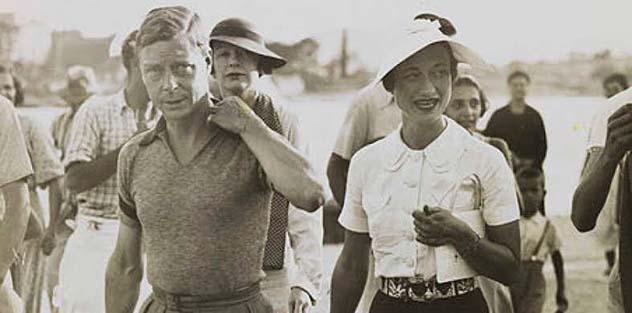
With such strong ties between Edward VIII and the Nazis, it should come as no surprise that there was one final, last-ditch attempt to win him over to the Nazi cause. Or, more accurately, take him over by force.
Once France had fallen to the Nazis in 1940, Edward & Wallis fled to Spain in order to evade capture. Although Spain was technically neutral at that point, it quickly declared a state of “non-belligerency”, which essentially meant supporting the Nazis when provoked. That explains why, when the Spanish Foreign Minister asked how to deal with the royals, Joachim Von Ribbentrop requested that they be detained for 2 weeks, but without letting them know it was at the request of the Nazis.
During this delay, the couple continued on to Portugal and Edward allegedly spoke about his dislike for the royal family, their policies, and their treatment of his wife. While the Nazis gleefully listened and agreed that he’d be much better without the Royals, Churchill heard about the conversations and sent 2 telegrams to Edward. The first ordered him to return to Britain, with a reminder that Edward was technically a military man and could face a court-martial; the second announced his new role as Governor of the Bahamas, and instructed him to go there immediately.
Although Edward was reluctant, he seemed to be giving serious consideration to the Governorship, and it was at this point that Hitler began Operation Willi,[6] a plan to kidnap the couple and either use them as peacebrokers or reinstall them on the throne of a German Britain. The first step of the plan was to intimidate the couple, which included throwing rocks through their windows, sending a bouquet of flowers with a threatening note, and spreading rumours amongst the staff that British intelligence was planning to assassinate the couple.
The operation came to a head on August 1st, when Hitler learned that the couple were making their way out of Portugal to the Bahamas. While the Spanish ambassador to Portugal tried to convince the couple not to go, the car carrying their luggage to the port was sabotaged, and a phoney bomb-threat was made against the ship they were supposed to be travelling on. Despite these efforts, the couple made their escape, bringing a decisive end to Edward’s relationship with the Nazis.
7 Charles Edward
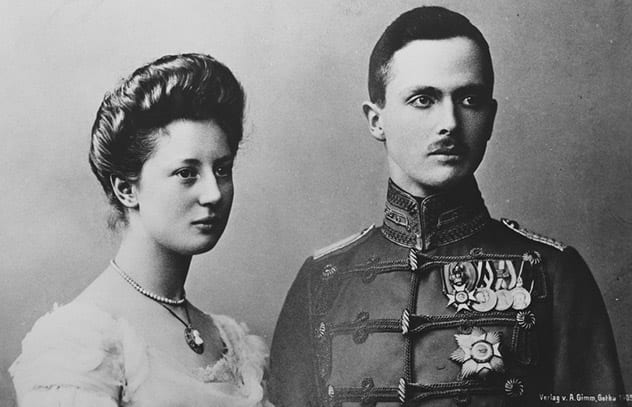
When Charles Edward was 16 years old, he was asked to move to Germany by his grandmother, Queen Victoria. Even though he had no knowledge of or desire to learn about German culture, the Queen had chosen him personally to become Duke of Saxe-Coburg and Gotha, where her husband was born and their family got its name, so he was shipped off without a second thought. In the ensuing years, he threw himself fully into his new life, ultimately marrying the niece of Wilhelm II, the last German Kaiser and King of Prussia.[7]
When World War One broke out and the house of Saxe-Coburg and Gotha became the house of Windsor, Charlie decided to side with his new family instead of the old. When George V was replaced by Edward VIII, Charlie wore a full Nazi military uniform to the funeral, and immediately set to work on leveraging Edward’s pro-German feelings to his advantage. After Edward’s abdication, Hitler appointed Charlie as President of the German Red Cross,[8] which sounds nice, but the position was really used to euthanize up to 100,000 disabled people. Despite his royal blood, Charlie was held in a brutal internment camp while he awaited trial after the war. Due to his deteriorating health, he was spared a prison sentence, but had essentially all of his wealth confiscated in fines.
6 Home Video
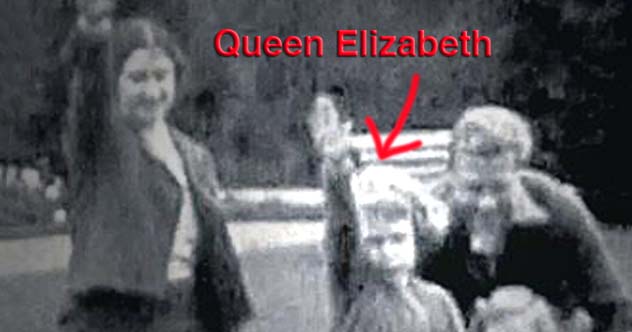
Because we now know so much about what the Nazis were doing during World War Two, it can be easy to look back with hindsight and wonder how people could have supported them or seen them as anything other than monsters. You can argue about how much people should have known and by when, especially when you see the information that was available at the time. But we could easily make the same arguments about all sorts of current political issues, so it should not come as a surprise to see well-known figures aligning themselves with the bad guys.
This was the essence of the statement put out by the Palace in 2015, when The Sun published a 17-second video of the royal family that was shot 82 years earlier.[9] The 1933 footage, believed to have been filmed in Balmoral, features the Queen Mother alongside Prince Edward and Princess Elizabeth, both of whom would go on to rule the nation. In it, all 3 are seen giving the Nazi salute, with Elizabeth giving the sign first and most frequently. Understandably, the Palace said that taking out-of-context footage of a child making a gesture before it had taken on any significance as a symbol of oppression was unfair criticism, but the video still made waves in the tabloids, and made people question what else the royal family may be sitting on.
5 Princess Alice
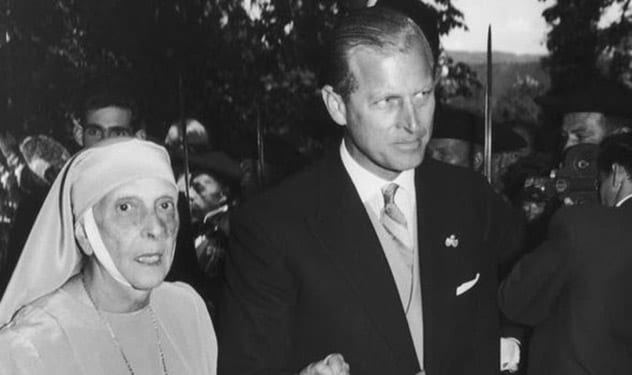
Although the Royal family does have some very questionable links to the Nazi regime, there are also some examples of Royal-Nazi relations that they can actually take some pride in. Probably the best example of this comes from Princess Alice of Battenberg (mother-in-law of Queen Elizabeth), also known as Princess Andrew of Greece and Denmark, after her husband. While most royals have some sort of charity-work to their names, Alice is one of the ones who truly devoted a lot of her time to helping those in need,[10] which many attribute to the fact that she was born partially deaf.
When the Nazis invaded Greece in 1943, Alice was contacted by Rachel Cohen, a Jewish widow of Haimaki Cohen, a longtime family-friend. Years earlier, Haimaki had helped King George, who promised to repay the favor one day. Although both men had since died,[11] Rachel reached out to to Alice seeking refuge from the occupying forces. While four of her sons planned to join the exiled Greek government in Egypt, Rachel and her daughter needed shelter in Athens, and were later joined by one of Rachel’s sons who failed to make the journey across the mediterranean sea. The Cohen family stayed with Alice until Greece was liberated from the Nazis the following year, during which time the Gestapo became suspicious of Alice and interviewed her at her home. Using her deafness to her advantage, Alice pretended she had trouble understanding the questions (she was a fluent lip-reader in three languages) and frustrated the process enough to keep the family safe until the war was over.
4 Nazi Costume

Even though most of the royal family’s Nazi-related anecdotes understandably take place around the 1940s, possibly their most well-known Nazi scandal was a lot more recent, having taken place in 2005. As many of you may remember, that was the year a 20 year-old Prince Harry dressed up as a Nazi while attending a private party.[12] As you can imagine, many members of the public were upset, and he quickly issued a public apology.
Since Harry was still living with his father at the time, the statement was issued by the office of their residence, Clarence House, and Charles ended up taking a lot of the heat. A book released in 2011 claims that even the Queen blamed Charles for the incident, calling into question his skills as a father. While the scandal did not ultimately do too much damage to the royals as a whole, it is undoubtedly something that will follow Harry around for the rest of his life.
3 Prince Ernst

Prince Ernst August of Hanover may not be the most famous prince, but he is pretty emblematic of royalty in the modern era: a descendant of Queen Victoria, whose father is brother-in-law to Queen Elizabeth, and who himself is married to Princess Caroline of Monaco, Prince Ernst is not really a prince of anywhere since Germany became a republic, although the family still uses the styling “of Britain and Ireland”, despite the fact that his relatives are the royals of Britain, and Ireland has none. In general, Ernst is most well-known for his controversies, such as public urination and aggravated assault.
Despite the fact that he was only born in 1954, Prince Ernst found himself tangled in a web of Nazi legal troubles as a result of his grandfather, who was also called Prince Ernst (Duke of Brunswick). In the 1990s, the youngest Ernst brought legal action against Bild-Zeitung,[13] Germany’s leading tabloid, which had claimed that his wealth was a result of Nazi operations against the Jewish community before, during, and after World War 2. The allegations were that the grandfather Ernst had taken huge, even majority, shares in Jewish-owned businesses, such as Munich Bank, and the largest construction firm in Germany at the time. Although they were never charged, both Prince Ernst’s grandfather and father (who was also called Prince Ernst) were Nazi supporters, with the middle Ernst even signing up to the SS. While that lawsuit went nowhere, the questions surrounding the Prince’s money persist to this day, with others claiming the family smuggled artefacts out of Germany to sell back to the German government after the war.
2 Princess Ileana

Despite being the great-granddaughter of both Queen Victoria and Tsar Alexander II (not together), Princess Ileana isn’t a very well-known historical figure. While she did lead a relatively exciting life, living through two world wars, the forced abdication of her father, and was exiled from her country, Ileana is probably most well-known (among those who know her at all) for her anti-communist speeches and books. But not everyone is convinced that her public proclamations were an accurate reflection of her private beliefs.
In 1953, Ileana’s cousin Archduke Franz Josef wrote to a Senator in New York (where Ileana was living at the time) to alert him that the Archduke would be bringing legal action against the Princess. In it, he claimed that Ileana was not the anti-communist heroine she would lead people to believe, and that she had in fact leveraged her position as a royal to benefit from the Nazi regime.[14] He claimed that when Hitler first invaded Austria, the Princess and her husband greeted him by telegraph. Because of this, Hitler allowed them to continue using their Royal titles, and the couple stayed in Nazi Austria for the next 7 years, schmoozing with the elites.
The Archduke also claimed that during this time, Ileana stole a number of his Austrian properties by travelling to Berlin and using her royal status to lay claim to the buildings. After Austria had been liberated from the Nazis, Ileana spent several years in Romania before moving to Argentina, where many Nazis fled after the war, before ultimately settling in America.
1 King George VI
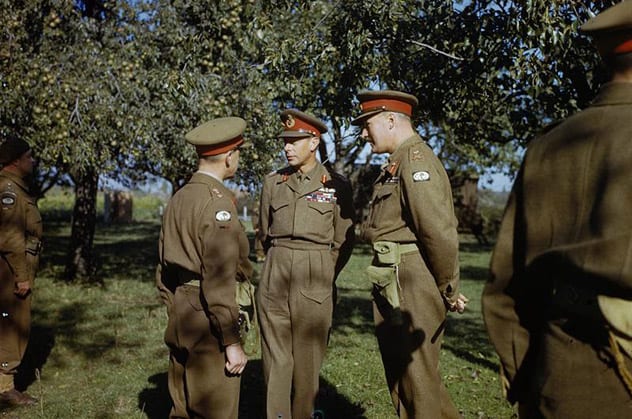
Even though his brother may have been working with Nazis behind the scenes, there seems to be no doubt that the loyalties of King George VI lay with the British. While the British were planning Operation Overlord, which would culminate in the Normandy landings, they enlisted the help of the King for Operation Fortitude, part of a larger plan to deceive the Nazis about the Normandy invasion.
Throughout 1944, King George, Queen Elizabeth (the Queen mother), and Princess Elizabeth made visits to the troops around Britain. That is pretty standard stuff, so the public wouldn’t have had any suspicions. But the hope was that the Nazis would.[15] The locations that the royals visited had been carefully selected to make the Nazis believe they were really there for planning, and the photo ops were just a cover. In reality, the sites they were visiting were intended to lead the Nazis away from Normandy, and suggested that Norway and Calais were the real targets. At the same time, newspapers published articles that “attempted” to conceal the location of the royals, while giving away just enough information for the Nazis to figure it out. In the end, the plan worked, with the Nazis taking the bait, and the Battle of Normandy is now seen as one of the main factors in their defeat.
For more lists like this, read 10 Times The Nazis Tried To Use Supernatural Powers, and 10 Tragic Facts About Hitler’s Wife.
About The Author: Simon can be found on Twitter @simongireland
